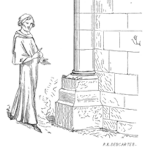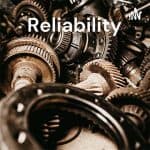
Influencing Change
Abstract
Chris and Fred discuss what it means (as a reliability engineer) to try and change something … even though the organization that thinks they are open to change really isn’t. What can we do?
ᐅ Play Episode
Your Reliability Engineering Professional Development Site
by Christopher Jackson Leave a Comment

Chris and Fred discuss what it means (as a reliability engineer) to try and change something … even though the organization that thinks they are open to change really isn’t. What can we do?
ᐅ Play Episode
by Mike Sondalini Leave a Comment

Below is an email discussion about when Crow-AMSAA modelling can provide believable forecasts.
by Carl S. Carlson Leave a Comment

Carl and Fred discussing how much of what we do as reliability professionals falls into the role of consultants. Learning how to be better consultants will enhance the results of our day-to-day work.
ᐅ Play Episode
by Larry George Leave a Comment

Suppose installed base or cohorts in successive periods have different reliabilities due to nonstationarity? What does that do to forecasts, estimates, reliability predictions, diagnostics, spares stock levels, maintenance plans, etc.? Assuming stationarity is equivalent to assuming all installed base, cohorts, or ships have the same reliability functions. At what cost? Assuming a constant failure rate is equivalent to assuming everything has exponentially distributed time to failure or constant failure rate. At what cost?
by Larry George Leave a Comment


As I rode, I thought, how could I use reliability statistics to optimize a solar-tube production line? Then I noticed a brass glint in the scrub brush. It didn’t look like trash, so I stopped and found an old brass oil lamp like Aladdin’s. Naturally, I rubbed it. There was a flash and a puff of smoke, and out popped the genie who said, “Yes master, by the powers vested in me, I grant you three wishes.”
[Read more…]
Welcome Bob and Ken Latino to the Podcast. Bob has been to this Podcast before discussing defect elimination and is an author involved with RCA and other reliability items. Briefly, Ken, can you introduce yourself.
I worked with Bob and my other brother at our family businesses called Reliability Centre for about 15 years. I later left for a small start up called Meridian being involved in reliability softwares. I also worked as a reliability manager at a Paper Mill for 10 years then went to GE. Presently doing consulting work Prelical.
In this episode we covered:

I needed multivariate fragility functions for seismic risk analysis of nuclear power plants. I didn’t have any test data, so Lawrence Livermore Lab paid “experts” for their opinions! I set up the questionnaires, asked for percentiles, salted the sample to check for bias, asked for percentiles of conditional fragility functions to estimate correlations, and fixed pairwise correlations to make legitimate multivariate correlation matrixes. Subjective percentiles provide more distribution information than parameter or distribution assumptions, RPNs, ABCD, high-medium-low, or RCM risk classifications.
[Read more…]by Christopher Jackson Leave a Comment

Sounds simple, right? And it is. Reliability growth literally refers to a process where we improve the reliability of a product, system, or service. But sometimes we find ourselves in situations where it is expected that not only do we understand reliability growth … but measure it. And predict how much it will grow in the future. This is sometimes called Reliability Growth Testing (RGT), Reliability Growth Planning (RGP), or Reliability Growth Prediction. And there are lots of equations and models for all these things. But do these models actually model the ‘real world?’ … can they work for you? … SHOULD they work for you? This webinar introduces you to the topic of reliability growth (both qualitative and quantitative) along with key concepts (like the Duane Failure Pattern) to help you work out if there is (or is not) a place for reliability growth in your organization.
[Read more…]by Christopher Jackson Leave a Comment

Chris and Fred discuss what are often seen as competing/different/complementary/friendly/unfriendly disciplines … systems and reliability engineering. How does one relate to the other?
ᐅ Play Episode
by James Reyes-Picknell Leave a Comment

As noted in other articles, performance measures are used to drive behaviors to make positive organizational changes in support of the organizational strategy and goals. However how well the performance measures may be developed and defined, if they are not effectively communicated to those individuals whose behavior is important to achieve the strategy and goals, then the performance measures have little value.
[Read more…]by Larry George Leave a Comment

How to allocate subsystems’ MTBF requirements with testing? Name-withheld-to-protect-the- guilty proposed “Top-Down” reduction in subsystem MTBF requirements; the more subsystems (in series) that you test, the lower the subsystem required MTBF! “The correct formula is
1/MTBF(subsystem requirement) = 1/MTBF(system requirement) –
((# of subsystems in series – # of subsystems tested)/MTBF(subsystem).”
This “Top-Down…” method is uncited and not found in Internet search.
[Read more…]by Akshay Athalye Leave a Comment

In this episode, we speak with Luke De Jager about Statistics and how much of it is necessary for Reliability Engineers. Understanding of Statistics remains an important aspect of any Reliability Engineers job. We talk about different distributions, why not use MTBF, and what is required to perform a good data analysis.
If you want to get in touch with Luke, you can contact him via LinkedIn (linkedin.com/in/luke-de-jager-2461b473)
“Destiny is no matter of chance. It is a matter of choice. It is not a thing to be waited for, it is a thing to be achieved.” – William Jennings Bryan
The Oxford English dictionary defines “reliability” as “the quality of being able to be trusted to do what somebody wants or needs.”
The textbook definition for “reliability” is “the probability that an item will perform its intended function for a designated period of time without failure under specified operating and environmental conditions.” [Read more…]

Reliability-based forecasts can be made from field data on complaints, failures, repairs, age-replacements (life limits), NTFs (no trouble found), WEAP (warranty expiration anticipation phenomenon), spares, warranty claims, or deaths. Some spares inventory forecasting software says… “Please enter forecast______” No kidding. 1800 years ago Roman Jurist Ulpian made actuarial pension cost forecasts for retiring Roman Legionnaires. Would you like actuarial forecasts? Their distributions? Stock recommendations?
[Read more…]by Bryan Christiansen Leave a Comment
Asset reliability programs are a set of initiatives for tracking the health, effectiveness and locations of both fixed and moveable assets. It involves routine maintenance, as well as the collection and analysis of equipment operating data to measure efficiency throughout their useful lives.
A good reliability engineering program provides insight on the frequency of asset failures, cost of operation, maintenance and repair, and the quality of maintenance work. Over time, an organization needs to evaluate metrics such as mean time between failures (MTBF), mean time to repair (MTTR), and mean time to failure (MTTF) to ascertain the suitability of the selected maintenance strategy. [Read more…]
 Ask a question or send along a comment.
Please login to view and use the contact form.
Ask a question or send along a comment.
Please login to view and use the contact form.